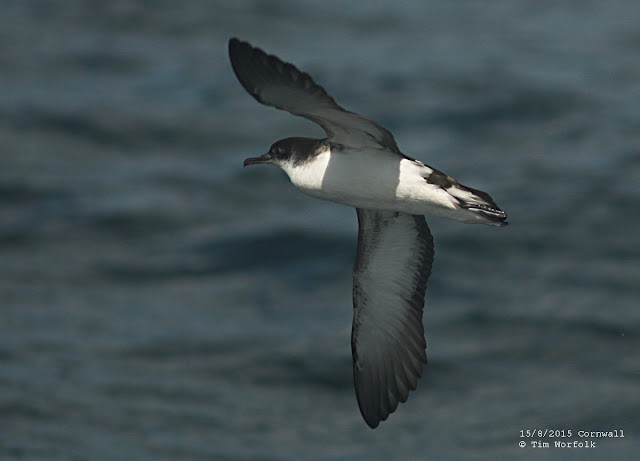15th October 2015, South Huish, Devon
This blog's been quiet of late and, to be honest, there's been little to write about. I can't remember the last decent bird I saw in Topsham. I've also been busy (which is good) and haven't been out and about as much as I would like recently (which is not so good). Still, news of an Isabelline (notice I didn't say 'Daurian') Shrike in South Devon got me out for a few hours this morning. Some of you may recall that many years ago I wrote a little piece for Dutch Birding on the subject of small eastern shrikes so you could say I have a 'professional' interest in these birds.
Luckily it didn't take much finding, in fact I walked right into it and for the next couple of hours it regularly appeared on the phone line or on the hedge by 'The White House' as described. While views were often very close - the bird was extremely tame and approachable - it nearly always stayed on the wrong side of the lane, backlit by the early sun. Once only it sat in a hawthorn on the 'right' side, I got a few photos through the branches but before I could edge round for a better view it was disturbed by a passing car - oddly, it didn't seem alarmed by people, only cars. Still, it performed well and regularly for the rest of the morning, hunting along the sunny side of the hedge and flying up to the wire to eat - mostly wasps.
 |
| Isabelline Shrike - 15/10/2015 South Huish, Devon |
Here's the little beauty in the hawthorn, as nice a nominate
isabellinus as you'll get. The important thing is the paleness of the upperparts and the lack of contrast with the pale, but slightly warm-toned, underparts; a typical
phoenicuroides would be darker above and whiter below. The ear coverts are perhaps a little darker than average (though most of the time they didn't look that striking) but the supercilium is poorly defined and the scalloping or wavy bars (squamations, anybody?) on the breast and flanks are faint and, in the sun, looked gingery; they're usually bolder and darker in
phoenicuroides. Another good character is the distinctly buff-tinged pale tone of the underparts, rather dirty-looking where a
phoenicuroides would look cleaner white.
 |
| Isabelline Shrike - 15/10/2015 South Huish, Devon |
 |
| Isabelline Shrike - 15/10/2015 South Huish, Devon |
Most of the time it gave views like these, very close but always against the sky with the sun in the 'wrong' place. The juvenile median and greater coverts are obvious, most or all of the contour feathers are by now second generation after it's first partial (post-juvenile or preformative, take your pick) moult.
 |
| Isabelline Shrike - 15/10/2015 South Huish, Devon | | |
This shot could have been so good, shame about the light, the camera and the photographer. It does show one thing however, see that long P9 (or P2 if you're an 'up-counter') on the left wing, it's nearly as long as the next one, P8, and might even be longer than P7; on
arenarius, the other Isabelline subsp. that just conceivably could occur in Europe, P2 is usually the same length or thereabouts as P6, on all the specimens I've examined it's never been as long as on this bird.
I said it mostly ate wasps, this is how a shrike deals with the sting; squeeze the abdomen untill the business end comes off then swallow (see what I mean about the light?).
 |
| Isabelline Shrike - 15/10/2015 South Huish, Devon |
 |
| Isabelline Shrike - 15/10/2015 South Huish, Devon |
 |
| Isabelline Shrike - 15/10/2015 South Huish, Devon |
 |
| Isabelline Shrike - 15/10/2015 South Huish, Devon |
To return to something I wrote earlier, why 'Isabelline' and not 'Daurian' Shrike? It's the same bird and 'Daurian' seems to have caught on in recent years. But does anyone know where Dauria is? I looked it up, It turns out it's an old name for the area east of Lake Baikal in the Russian far east; on old maps it used to known as 'Daooria' so maybe we're all pronouncing it wrong as well. All well and good, it sounds exotic, but the problem I have with the name is that you won't find too many 'Daurian' Shrikes in Dauria, Brown Shrikes certainly but not a lot of
Lanius isabellinus. Our bird breeds mainly in Mongolia and northern China (the form
arenarius appears to be limited to the Tarim Basin in Xinjiang). So if you want to give it a geographic name, why not 'Mongolian Shrike'? Personally I've always liked the sound of 'Isabelline' and if you really want to know why it's 'isabelline' (the colour of unwashed linen and not, by the way, 'soiled undergarments' as I've sometimes heard), stop me and ask me sometime.
Finally, here's one I made earlier, as they say. In March I was invited to Helsinki to talk about Shrikes, I was unsatisfied with my previous attempts so I painted this comparison to illustrate what I see as the main differences between 'typical'
isabellinus and
phoenicuroides - or Isabelline and Turkestan, if you like.
 |
| Isabelline and Turkestan Shrikes - 'typical' 1st winters |
Many thanks to Richard Stafford for finding it, and Mike Passman and Alan Doidge etc for getting the news out.























































